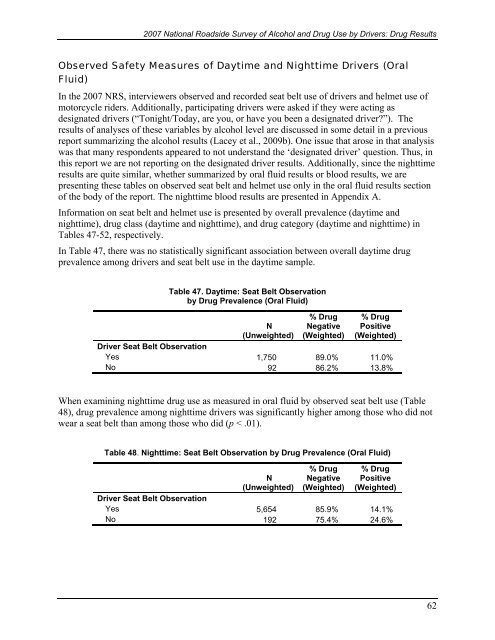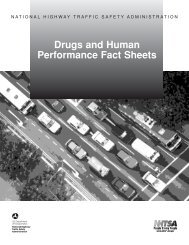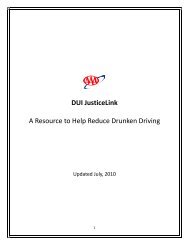2007 National Roadside Survey of Alcohol and Drug Use by Drivers
2007 National Roadside Survey of Alcohol and Drug Use by Drivers
2007 National Roadside Survey of Alcohol and Drug Use by Drivers
You also want an ePaper? Increase the reach of your titles
YUMPU automatically turns print PDFs into web optimized ePapers that Google loves.
<strong>2007</strong> <strong>National</strong> <strong>Roadside</strong> <strong>Survey</strong> <strong>of</strong> <strong>Alcohol</strong> <strong>and</strong> <strong>Drug</strong> <strong>Use</strong> <strong>by</strong> <strong>Drivers</strong>: <strong>Drug</strong> ResultsObserved Safety Measures <strong>of</strong> Daytime <strong>and</strong> Nighttime <strong>Drivers</strong> (OralFluid)In the <strong>2007</strong> NRS, interviewers observed <strong>and</strong> recorded seat belt use <strong>of</strong> drivers <strong>and</strong> helmet use <strong>of</strong>motorcycle riders. Additionally, participating drivers were asked if they were acting asdesignated drivers (“Tonight/Today, are you, or have you been a designated driver?”). Theresults <strong>of</strong> analyses <strong>of</strong> these variables <strong>by</strong> alcohol level are discussed in some detail in a previousreport summarizing the alcohol results (Lacey et al., 2009b). One issue that arose in that analysiswas that many respondents appeared to not underst<strong>and</strong> the ‘designated driver’ question. Thus, inthis report we are not reporting on the designated driver results. Additionally, since the nighttimeresults are quite similar, whether summarized <strong>by</strong> oral fluid results or blood results, we arepresenting these tables on observed seat belt <strong>and</strong> helmet use only in the oral fluid results section<strong>of</strong> the body <strong>of</strong> the report. The nighttime blood results are presented in Appendix A.Information on seat belt <strong>and</strong> helmet use is presented <strong>by</strong> overall prevalence (daytime <strong>and</strong>nighttime), drug class (daytime <strong>and</strong> nighttime), <strong>and</strong> drug category (daytime <strong>and</strong> nighttime) inTables 47-52, respectively.In Table 47, there was no statistically significant association between overall daytime drugprevalence among drivers <strong>and</strong> seat belt use in the daytime sample.Table 47. Daytime: Seat Belt Observation<strong>by</strong> <strong>Drug</strong> Prevalence (Oral Fluid)N(Unweighted)% <strong>Drug</strong>Negative(Weighted)% <strong>Drug</strong>Positive(Weighted)Driver Seat Belt ObservationYes 1,750 89.0% 11.0%No 92 86.2% 13.8%When examining nighttime drug use as measured in oral fluid <strong>by</strong> observed seat belt use (Table48), drug prevalence among nighttime drivers was significantly higher among those who did notwear a seat belt than among those who did (p < .01).Table 48. Nighttime: Seat Belt Observation <strong>by</strong> <strong>Drug</strong> Prevalence (Oral Fluid)N(Unweighted)% <strong>Drug</strong>Negative(Weighted)% <strong>Drug</strong>Positive(Weighted)Driver Seat Belt ObservationYes 5,654 85.9% 14.1%No 192 75.4% 24.6%62




